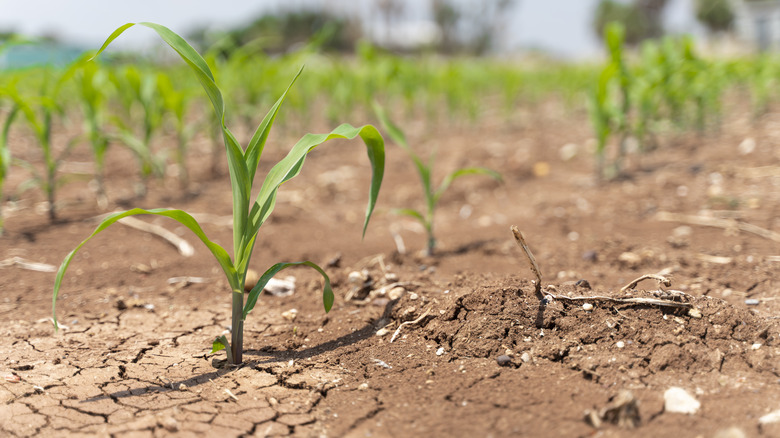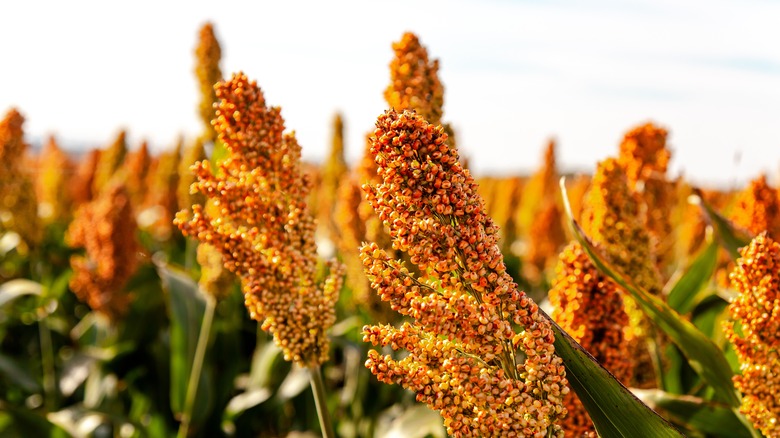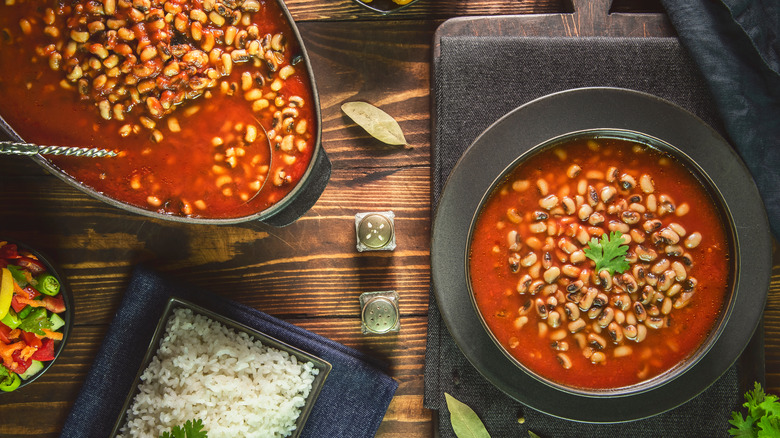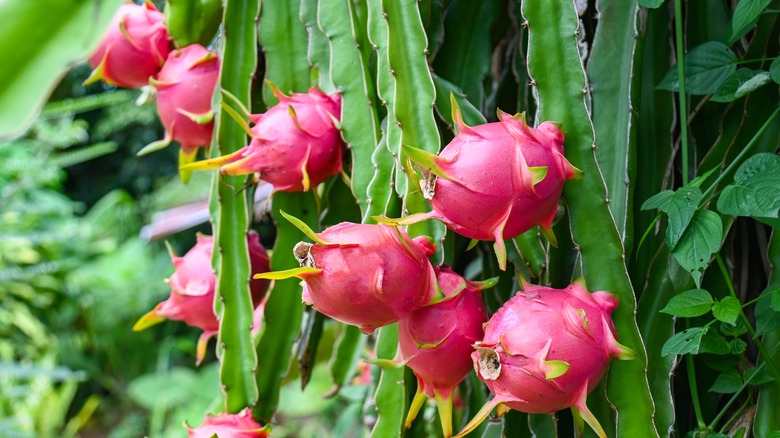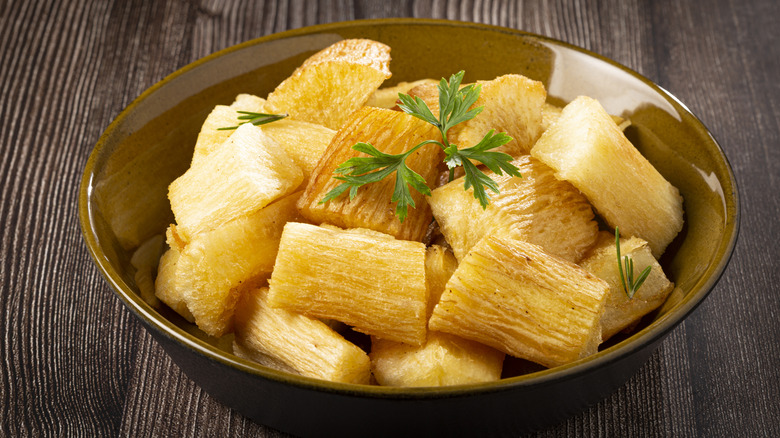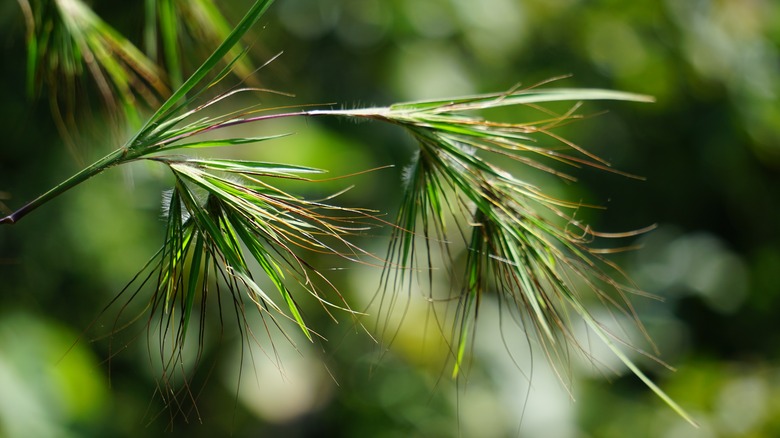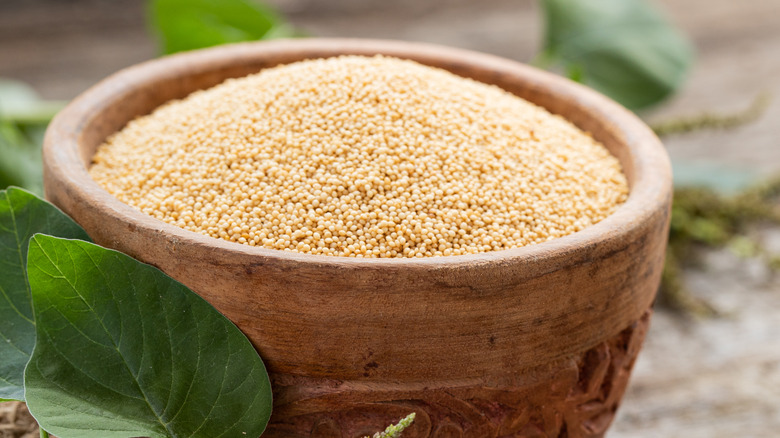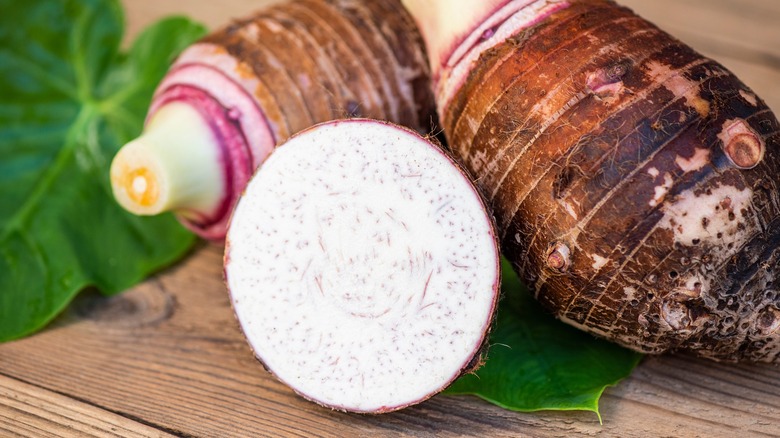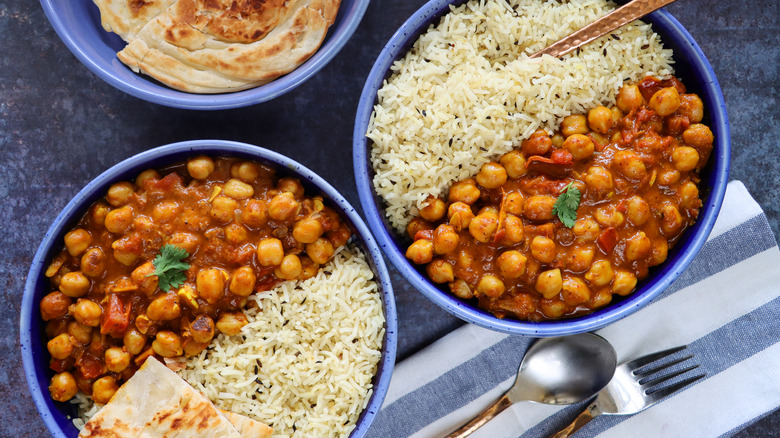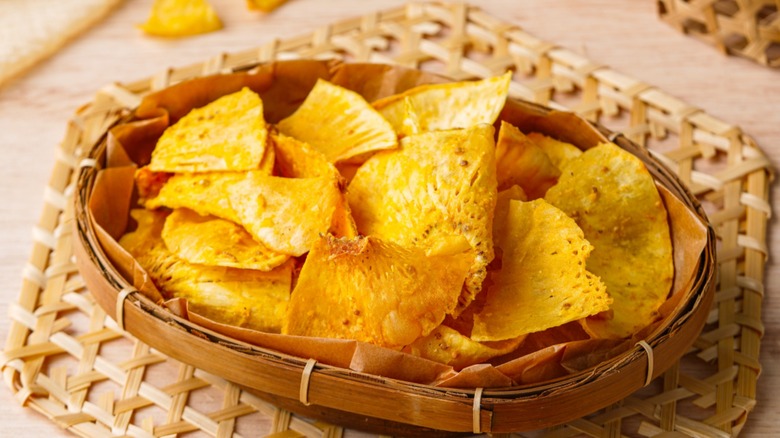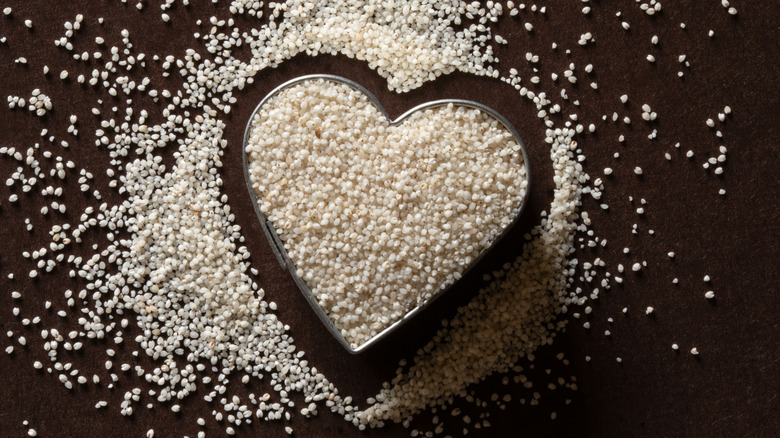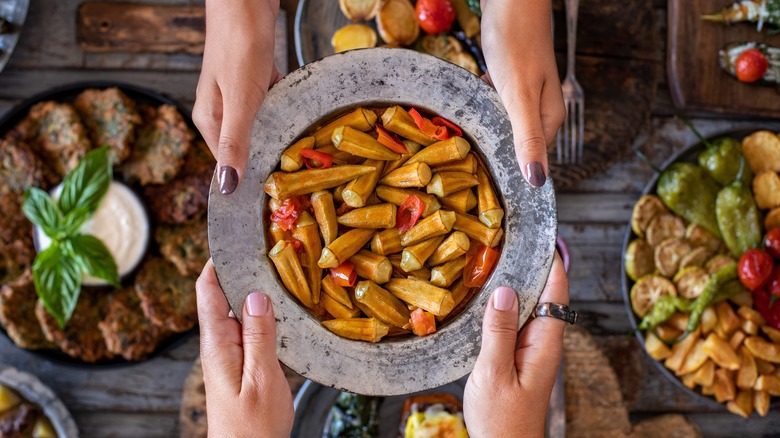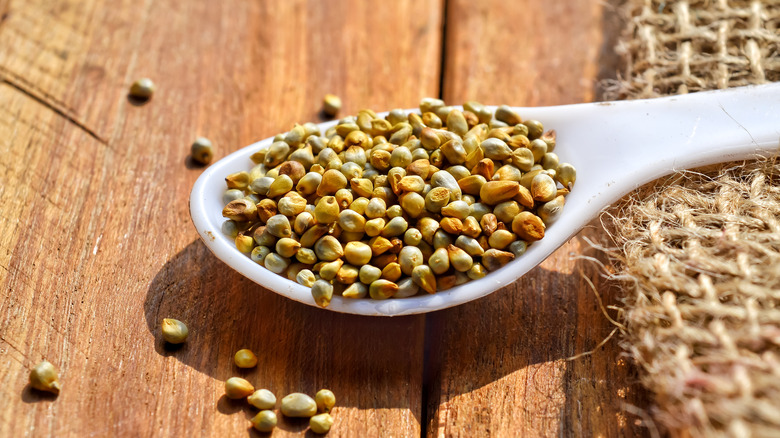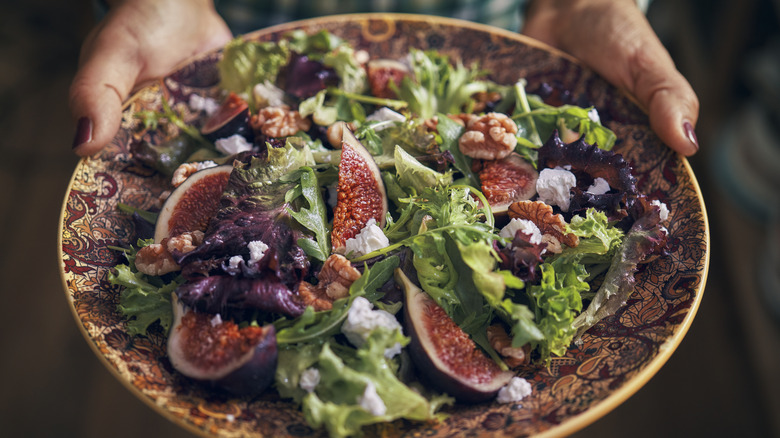13 Future Foods That Could Help Us Survive Climate Change
As Earth's climate changes, with new heat records and unusually dry weather being recorded every year, farms are feeling the strain. Some of the most dire impacts of the changing climate are felt by agriculture, affecting both the farms themselves and the rural workers who tend them. As the EPA explains, this industry is more susceptible than most to environmental conditions because of its heavy reliance on land quality and water supply. Numerous everyday crops are already under threat by climate change. This includes luxury goods like cocoa and coffee, but also vital staples like corn and potatoes. Some studies have found that crop yields of rice and wheat are already declining. According to NASA, within the next decade, this is likely to become steadily worse, with yields of maize expected to fall by almost 25%.
The world's top four staple crops are wheat, potatoes, maize, and rice. On a warmer planet, though, with more extreme weather and greater numbers of pests, suitable growing lands for these will change. While warmer conditions may benefit some farmlands, others will likely see the crops they've been growing for decades start to struggle as temperatures continue to rise, pushing farmers to try growing new crops instead. Experts suggest that diversifying their fields will be a winning strategy, helping farms to survive while still supplying enough food to feed everyone else. An often overlooked point, too, is that as well as improving sustainability, farms will need to account for local tastes and culture. Here are some foods that could help farms and humans thrive as climate change continues to impact the world.
1. Sorghum
While less common on the dinner table in Western countries, sorghum is the fifth most produced grain in the world today, according to Healthline. A healthy cereal rich in nutrients like vitamin B, iron, magnesium, and potassium, sorghum comes in a few varieties — and colors! Some sorghum is orange, red, purple, or black. In the U.S., it's mostly used as a feed grain for livestock, but it's also a common part of human diets in several countries around the world. The plant itself grows well in hot climates, being very good at tolerating heat. It's adapted to use water very efficiently, making it able to withstand dry spells, and it's even better at using sunlight than some other grains, like rice. Sorghum is one of a select group of plants that have evolved to use a more efficient form of photosynthesis, helping to make it a very productive crop to grow.
In the kitchen, sorghum can be used in much the same way as any other cereal, and makes a healthy addition to anyone's diet. Commonly found in several African and Asian cuisines, the grains can be added whole into soups and stews, much like pearl barley. Free from gluten, it can be ground into flour and used to make bread. It can even be boiled and used in the same way as grains like rice or quinoa. For those who want to try cooking with it, sorghum grains are already available from some grocery retailers.
2. Black-Eyed Peas
Future foods don't necessarily need to be new. Some, like black-eyed peas, are surprisingly old. Sometimes called cowpeas, they're actually one of the world's oldest cultivated crops, originally from Africa but now grown and eaten all over the planet. They're also a very drought-tolerant crop, much more so than some other legumes like soybeans. West Africa, the original home of the black-eyed pea, is still one of the places they're most often eaten, and Nigeria is currently the world's top grower of them. They're also an efficient crop to farm for food because the entire plant is edible. As well as the beans themselves, the plant's leaves can be eaten as a tasty green vegetable.
Black-eyed peas aren't difficult to cook, and many a kitchen enthusiast has likely tried making them before. Much like other pulses and legumes, they work excellently in soups and stews. They can also be made into flour, which is used in some African recipes from countries like Ghana and Sierra Leone. With a nutty flavor, black-eyed peas have a lighter taste than some other beans, but a more savory flavor than garden peas. When cooked, they also have a slightly firmer feel than other beans, like pinto beans. In North America, black-eyed beans are often used in cooking from the Southern U.S. states, where it's traditionally good luck to eat them for New Year's Day.
3. Pitayas
Sometimes better known by the name of dragonfruit, pitayas are cactus fruit, making them perfectly suited to grow in hot arid dry conditions. The only trouble for hopeful cactus farmers is that pitayas take time to yield crops. Like many cacti, they grow slowly, and it can take seven years to go from planting seeds to harvesting fruit. Climate change is likely to increase the growing range for pitayas in the coming years, making it easier to grow them further north. For the warmer climate of the future, they're considered a promising crop, being not just a nutritious and healthy food, but also having a few uses in other industries like cosmetics.
Despite the stereotypical picture some people may have of cacti, the pitaya cactus is a sprawling, vine-like plant often grown on trellises. The fruit is a traditional food of the Seri people from Sonora. While the fruit is native to Central America, they've also become very popular in Southeast Asia. Low in calories and high in fiber, pitayas have a very mild flavor, aren't very sweet, and have a melon-like texture. When diced, they can go very nicely in salads or smoothie bowls. Coming in two varieties, with white and deep red flesh, they can also make for an eye-catching addition to any plate.
4. Cassava
Also known as yuca or manioc, cassava is a large, starchy root tuber. It grows well in hot climates where the water and nutrients stored in the plant's thick roots make it good at tolerating heat waves and droughts. As long as it has a long growing season, the only crops that produces more food per acre are bananas and potatoes. Cassava has a nutty, earthy taste and is a popular part of cuisines in the Caribbean, South America, Africa, and some Asian countries. While it's widely eaten though, it comes with one important caveat — cassava cannot be eaten uncooked. In fact, it's toxic when raw, only becoming safe to eat when properly peeled and cooked. Peeling cassava is best done with a sharp knife rather than a potato peeler, thanks to its thick, waxy skin.
In the kitchen, cassava can be cooked in similar ways to potatoes. It can easily be chopped and made into fries or even chips. It can also be dried and ground into flour and is quite a popular ingredient in gluten-free baking. Notably, it's also used to make tapioca. Some of the more interesting uses for cassava come from Southeast Asia, where it can also be made into sweet dishes. A favorite dessert in the Philippines is cassava cake. Slightly chewy, with a soft, custardy flavor, it's made with coconut and grated cassava.
5. Themeda
Themeda is a grain native to Australia, where it sometimes goes by the name of kangaroo grass. Found growing wild in grasslands and woodlands all across the country, it also grows in Asia and Oceania. As a testament to how well suited it is for hot climates, this ornamental grass is one of several plant species whose seeds are adapted to start growing after wildfires or heatwaves in excess of 105 degrees Fahrenheit. Like sorghum, themeda is an adaptable plant, good at surviving droughts and efficient at using strong sunlight. It's also a perennial grass, which could be a big bonus for sustainability. A study in the journal Frontiers in Plant Science suggests that perennial grains could be a promising type of future crop.
Themeda has been largely overlooked by modern Westernized society, but it's been a traditional food source for Indigenous Australians going back tens of thousands of years. Recently, this has prompted some Australians to start exploring the potential of this ancient grain as an emerging crop. In breads, both as flour and a whole grain, it has a distinctive, slightly grassy flavor. Essentially, in any food where wheat can be used, themeda can work just as well. With the ever-encroaching threat of climate change, enthusiasts are eager to promote the cultivation of Indigenous grains.
6. Amaranth
Amaranth is another crop in which the whole plant is edible. It's even used in different ways depending on what cuisine it's found in. In Africa and Asia, it's traditionally enjoyed as a leafy vegetable, while Native Americans have always harvested the grains from their colorful seed plumes. Like buckwheat, amaranth is a pseudocereal, and it's very good at surviving droughts. A tenacious vegetable, when the Spanish banned Native Mesoamericans from growing amaranth, the plant survived by growing as a weed. In recent years, farmers across both North and South America have been investigating growing it on a larger scale for its hardiness and ability to thrive in hotter climates.
As a grain, amaranth is very similar to quinoa, with the biggest difference being that it prefers to grow in hot climates. The whole grains can be boiled and served like rice or made into porridge, or they can be ground into gluten-free flour for baking. According to Healthline, the grain is packed with fiber and protein, rich in manganese and magnesium, and some studies have shown that eating it may help to reduce cholesterol. As a green vegetable, amaranth leaves work very well in stir-fry, and are the main ingredient in a type of stew known as biteku teku in Central Africa.
7. Taro
Taro is a tuberous root vegetable and a traditional dietary staple in Southeast Asia and Polynesia. The plant is so well adapted to hot climates that it can't survive colder winters — though farmers in North America have been working on acclimatizing the plant to grow in temperate environments more easily. This is important for two reasons — it can be a useful plant to grow as colder regions continue to warm, and it can also help to keep a good supply of the crop as its natural habitats become threatened by the changing climate. Taro is one crop that doesn't do so well in droughts though. While it favors hot climates, it also needs wet environments to thrive. In Asia, it's often grown in paddy fields, like rice.
Both the roots and leaves of the taro plant can be cooked and eaten. The starchy taro root can be cooked similarly to a potato, being boiled, steamed, or fried. The taro leaves are a traditional staple in Hawaii, where they're known as luau leaves. They're used to wrap a popular Hawaiian dish called lau lau, which is often served with a thick paste called poi made from pounded taro root. In East Asia, taro is also a popular flavor for bubble tea, easily recognizable by its distinctive purple color.
8. Chickpeas
Anyone familiar with the cuisines of South Asia, the Middle East, and the Mediterranean will no doubt be familiar with chickpeas. Also known as garbanzo beans, they're a protein-rich food staple and the plant manages dry conditions better than other legumes, thanks to their deep roots. Considered one of the most important legumes cultivated in the world today, chickpeas are still susceptible to stress from dry conditions and excessive heat, but researchers are working to breed species better able to withstand extreme weather conditions.
For inspiration on how to cook with chickpeas, all you need to do is look to Asia. In India, where they're a staple, there are numerous recipes that include them, and some in which they're the main ingredient, like a vegan curry called chana masala. An incredibly versatile food, they can be used to make things like falafel, hummus, and a type of flatbread called socca — meaning that it's technically possible to make an entire varied meal mostly from chickpeas.
9. Breadfruit
Breadfruit trees are considered one of the most productive food crops in the world, growing in some of the warmest parts of the Earth, like the Caribbean, Hawaii, and Indonesia. Adaptable and resilient against the ravages of climate change, like higher temperatures and variable rainfall, some scientists consider breadfruit to be one of the most promising foods to cultivate in a warming world. Healthy trees can withstand prolonged heat and drought — though if conditions become too severe, they may still drop their fruit early. The tree is originally from Oceania, and its fruit is a staple in some parts of Southeast Asia, where it's cooked in a very similar way to potatoes. These starchy, savory fruit have even earned the nickname of "tree potatoes" for their taste and texture.
The breadfruit itself is just as versatile as root tubers like potato or cassava. It can be boiled, roasted, or fried, and can even be sliced thin and made into chips. A variety of different recipes can be made with breadfruit, from stews to cakes. The whole fruit can even be grilled and eaten like a baked potato. Growing as large as a cantaloupe melon, though, a single baked breadfruit may be too much for a single person to manage and is best shared.
10. Fonio
In West Africa, fonio is a traditional cereal with a nutty flavor and a texture similar to quinoa or couscous. It's known as Africa's oldest grain, and it's been cultivated for millennia. Historically, it's been given great value at times, being served on holy days in places like Mali and Senegal. Fonio is also an extremely resilient crop. It's good at withstanding drought conditions, and can be grown in poor-quality soil, making it an attractive crop for places hit by both climate change and soil erosion problems. As an extra bonus, it's a nutritious grain, and is both gluten-free and with a low glycemic index. This makes fonio an attractive choice for people with some dietary restrictions.
Fonio, like other grains, can be cooked similarly to things like rice. Boiled, it has a similar firm texture to quinoa with a flavor that's stronger, but not so much as to overpower anything it's being served with. As well as being boiled, fonio can also be ground into flour and used to make both breads and cakes, and its distinctive flavor can go very nicely in recipes like pound cake.
11. Okra
Okra sometimes bears the rather unusual name of lady's fingers, and it comes in a few different varieties. All do best in warm climates where there's no chance of frost, but some are more climate change-resistant than others. The plant likes strong sunlight, can grow well in hot conditions, and a few particularly hardy cultivars are extra tolerant to drought. There's a good chance most chefs, both professional and amateur, will already be familiar with okra. After all, it's eaten in cuisines from around the world. From South Asia to South America, from the Mediterranean to the Caribbean, okra is never too difficult to find.
For those who aren't already acquainted with it, okra has a firm, crisp texture and a gentle, leafy flavor that's quite unlike anything else. It's used in all manner of cuisines and is often added to curries and stews, roasted, or even deep fried, sometimes after being battered for extra crunch. In Japan, it's popularly served in salads.
12. Pearl Millet
For the places hit hardest by climate change, pearl millet is a promising crop to grow. It's extremely resilient to dry conditions, and is already grown in places where rainfall is low and unreliable. The plant is evolved to be resistant to conditions so dry that they'd kill many other cereal crops, and it uses the same kind of efficient photosynthesis as crops like sorghum. Pearl millet is also able to withstand dramatically hotter weather than many other crops, able to keep producing grains at temperatures of up to 107 degrees Fahrenheit. A tough little plant, it's also very efficient at using nitrogen in the soil, and it can grow well with less fertilizer than other cereal crops.
The grains of pearl millet are nutritious and rich in protein and fiber, but they're also difficult to cook compared to other cereals. This tough little plant produces tough little grains that need to be soaked overnight like dried beans, to soften them up. When ready to cook, they're added to soups and stews in South Asia, where the grain often goes by the name of bajra. Like most other grains, pearl millet can be boiled whole like rice, to accompany other dishes. Gluten-free, the grains can also be ground into flour and used in baking, and can make good flatbreads like Indian roti.
13. Figs
Figs are another example of a future food which is also a food of the distant past. These sweet and distinctive-tasting fruits are one of the oldest crops cultivated by humanity, with a history dating back to Neolithic times. They're also very hardy plants. They prefer strong sunlight and are widely considered one of the most drought-resistant fruit trees to grow. That said, fig trees aren't resistant to dryness from the get-go, and need plenty of water to become established first.
While figs are delicious to eat raw, straight from the tree, they also have some versatile culinary uses. Figs can make an excellent addition to some cakes and tarts, and can make rich-tasting jams and chutneys too. While undoubtedly a very sweet fruit though, the rich flavor of figs can also taste excellent in savory dishes. Sliced, they can go nicely on bread, including pizza, or can be diced and added to salad. One flavorsome option to try is to quarter and oven-roast them with a little rosemary.
